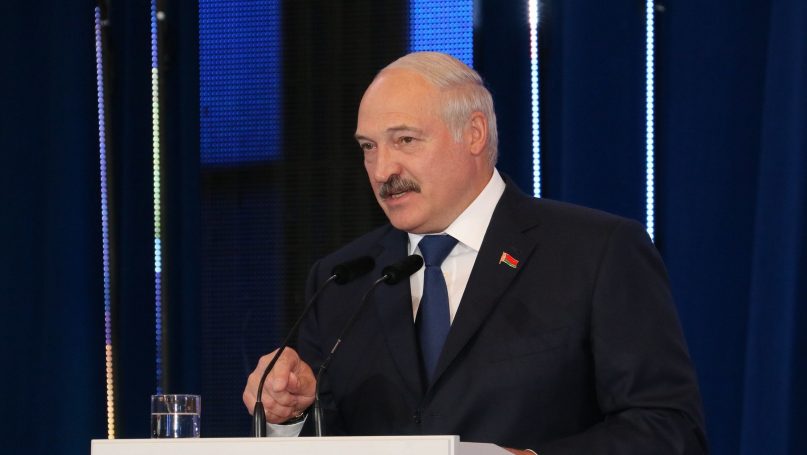
This is an excerpt from Understanding Ukraine and Belarus: A Memoir by David R. Marples. Download your free copy on E-International Relations.
On Saturday, May 9, there took place a Covid-19 experiment. The centre was Minsk, Belarus, and the initiator its president-for-life Aliaksandr Lukashenka. It commemorated the 75th anniversary of the end of World War II in Europe—Victory Day—with a public parade in which the participants did not wear masks. How, one wonders, could such an experiment take place in the middle of a pandemic? It is a valid question given that in the Russian capital of Moscow, where Victory Day is sacrosanct, the parade was cancelled. Lukashenka plays the role of a country hick, a former collective farmer, a hayseed, who believes Covid-19 is a psychosis and has stated more than once that no deaths on the republic have been a result of it. He has commented that he will provide apples and milk for the participants as it is known that these products are good for health.
Belarus continues to see more than 950 positive cases each day. The death toll, while not catastrophic by European standards, exceeded 150 by mid-May. In the midst of this, the question needs to be asked: why? What is the point? Why risk the help of conscripts and the general public for a commemorative event for a date that very few can still remember. Any active participants would be at least 93 by now, in a republic where males live on average less than 70 years and women just over 70. Lukashenka himself has acknowledged that only about 4,000 war veterans are still alive.
The answer appears to be that Victory Day means more to Lukashenka than the lives of the people he governs. The symbolism of the event encapsulates a national narrative of a republic that is steeped in wartime history to the exclusion of all before and after. The pantheon of heroes includes a suspiciously high number of Stalinist henchmen: foremost among them being Panteleimon Ponomarenko, the party leader and officially appointed head of the Partisan movement, despite the fact that he fled to Moscow immediately after the German army crossed the border.
The whole period is steeped in myth. Seventy kilometres from Minsk is the outdoor Stalin Line Museum, the fortification line that allegedly prevented the Nazi hordes from reaching Moscow. The fact that is was disbanded long before the Wehrmacht arrived, and the border moved westward with the incorporation of eastern Poland after September 17, 1939, is simply brushed aside. A large bust of Stalin greets visitors at the entrance, usually adorned with wreaths. This is history for today.
On the other side of Minsk is Kurapaty, a mass graveyard for victims of Stalin, courtesy of the NKVD, one of numerous killing grounds of the period 1937-1941, officially recognized with a monument after thirty years of protests (November 2018), but now fenced off by the authorities, which also uprooted more than 100 crosses planted there by non-government organizations. The KGB archives, which likely would provide more enlightenment of these murders, has been closed since 1994, the year that Lukashenka became president.
But Kurapaty does not represent official thinking. The official memorial of the ‘Great Patriotic War’ is at Khatyn, about 50 kilometres from Minsk, a village destroyed by police forces working for the Nazis, and representing all the villages destroyed by the German occupation. The authorities of the contemporary state commemorate one tragedy but ignore the previous one, which in fact is implicitly glorified as the war victors. And the president forges a lone path to do so, even today when the consequences could be catastrophic. The past can be glorified but the present means nothing: people can be sacrificed for a whim.
The world barely paid attention to these events in a republic of 9.4 million, less than the population of London or Shanghai. But they reflect the legacy of the Soviet period, which for some has been difficult, if not impossible, to cast aside. Lukashenka is not a stupid man, he is an astute political animal who has steered his republic through a number of crises and avoided the sort of fate accorded to parts of Ukraine.
Some Europeans and even some Americans consider him the most reliable bulwark against Russian encroachment in central Europe. For whatever reason, he went too far this time and decided that the value of human life is minimal. It is akin to forcing the people of Kyiv to march in the 1986 May Day parade after Chernobyl: an act of knowing folly, if not criminal intent.
And as with Chernobyl, two weeks later it will be impossible to decipher whether those who die did so because of the parade, because of the virus, or as a result of other, perhaps unrelated or underlying reasons. That does not detract from the enormity of the decision to allow the parade to take place. Lukashenka may or not may be the last dictator of Europe. But that he has risked the lives of thousands for a commemorative event is undeniable. It may be the epitaph of his lengthy presidency.
Further Reading on E-International Relations
- COVID-19 and Democracy in the European Union
- Nigeria’s Soft Power in the Face of COVID-19
- Battling Fake News and (In)Security during COVID-19
- Opinion – Identity Politics and COVID-19 in Myanmar’s Rakhine State
- Opinion – COVID-19 and the Coming Crisis in America
- Bolsonaro’s Brazil in Times of COVID-19: A Necropolitical Pharmakon